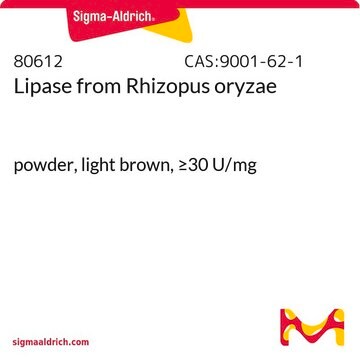추천 제품
생물학적 소스
Aspergillus sp. (A. oryzae)
Quality Level
형태
solution
농도
≥100000 units/mL
기술
DNA purification: suitable
적합성
suitable for nucleic acid purification
응용 분야
cell analysis
배송 상태
wet ice
저장 온도
−20°C
유사한 제품을 찾으십니까? 방문 제품 비교 안내
일반 설명
The Nuclease S1 enzyme from Aspergillus oryzae has the ability to degrade single-stranded oligonucleotides composed of either deoxynucleotides or ribonucleotides.
애플리케이션
Nuclease S1 from Aspergillus oryzae has been used in a study to assess a biochemical method for mapping mutational alterations in DNA. It has also been used in a study to investigate the DNA damage and repair in a γ-irradiated rat brain tumor.
생화학적/생리학적 작용
Nuclease S1 isolated from Aspergillus oryzae exhibits endo- and exolytic hydrolytic activity for the phosphodiester bonds of single-stranded DNA and RNA yielding 5′-phosphomononucleotide and 5′-phosphooligonucleotide end-products. It is used to digest non-annealed polynucleotide tails and hairpin loops in RNA and DNA duplexes and can be used to convert superhelical DNA to the linear form.
SI nuclease from Aspergillus oryzae can generate double-stranded DNA breaks in response to DNA nicks or abasic sites.
단위 정의
One unit will cause 1.0 microgram of single-stranded nucleic acid to become perchloric acid soluble per minute at pH 4.6 at 37°C.
물리적 형태
Solution containing 30 mM sodium acetate, 50 mM NaCl, 1 mM ZnCl2, 50% glycerol, 2 mg/ml protein
키트 구성품 전용
제품 번호
설명
- 30mM Sodium acetate .25-.25 %
- 50mM Sodium chloride .29 %
- 1mM Zinc chloride .01 %
- Glycerol 50 %
- 2mg/mL Protein .2 %
Storage Class Code
10 - Combustible liquids
WGK
WGK 2
Flash Point (°F)
Not applicable
Flash Point (°C)
Not applicable
시험 성적서(COA)
제품의 로트/배치 번호를 입력하여 시험 성적서(COA)을 검색하십시오. 로트 및 배치 번호는 제품 라벨에 있는 ‘로트’ 또는 ‘배치’라는 용어 뒤에서 찾을 수 있습니다.
이미 열람한 고객
M A Chaudhry et al.
Nucleic acids research, 23(19), 3805-3809 (1995-10-11)
Defined DNA substrates containing discrete abasic sites or paired abasic sites set 1, 3, 5 and 7 bases apart on opposite strands were constructed to examine the reactivity of S1, mung bean and P1 nucleases towards abasic sites. None of
P Beard et al.
Journal of virology, 12(6), 1303-1313 (1973-12-01)
S(1) nuclease, the single-strand specific nuclease from Aspergillus oryzae can cleave both strands of circular covalently closed, superhelical simian virus 40 (SV40) DNA to generate unit length linear duplex molecules with intact single strands. But circular, covalently closed, nonsuperhelical DNA
Rebecca Rodell et al.
Methods in molecular biology (Clifton, N.J.), 2444, 125-140 (2022-03-16)
Physiological and chemically induced modifications to nucleosides are common in both DNA and RNA. Physiological forms of these modifications play critical roles in gene expression, yet aberrant marks, if left unrepaired, may be associated with increased genome instability. Due to
Marwan Hassani et al.
iScience, 24(8), 102913-102913 (2021-08-20)
Mepolizumab (anti-IL-5) is a successful biological for treatment of T2/eosinophilic asthma by blocking the IL-5-eosinophil axis. The kinetics of human eosinophils in blood and sputum was determined to better understand the underlying mechanism(s). Pulse-chase labeling was performed with 6,6-2H2-glucose in
F Harada et al.
Nucleic acids research, 2(6), 865-871 (1975-06-01)
Nuclease S1 specifically hydrolizes tRNAs in their anticodon loops, forming new 5' phosphate and 3' OH ends. Some single-stranded regions are not cut by nuclease S1. The strong preference of nuclease S1 for the anticodon region can be used for
프로토콜
Spectrophotometric assay at 260 nm measures nuclease S1 activity, vital for nucleic acid research, with defined enzyme unit criteria.
자사의 과학자팀은 생명 과학, 재료 과학, 화학 합성, 크로마토그래피, 분석 및 기타 많은 영역을 포함한 모든 과학 분야에 경험이 있습니다..
고객지원팀으로 연락바랍니다.










